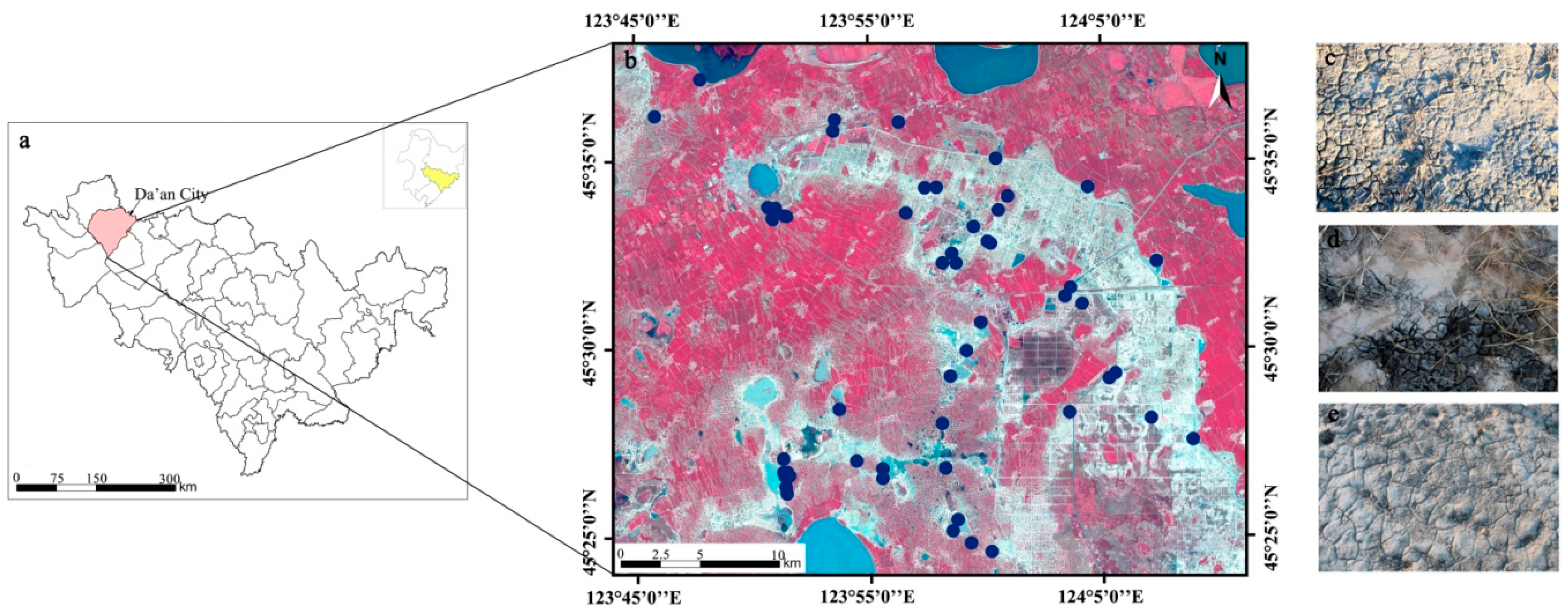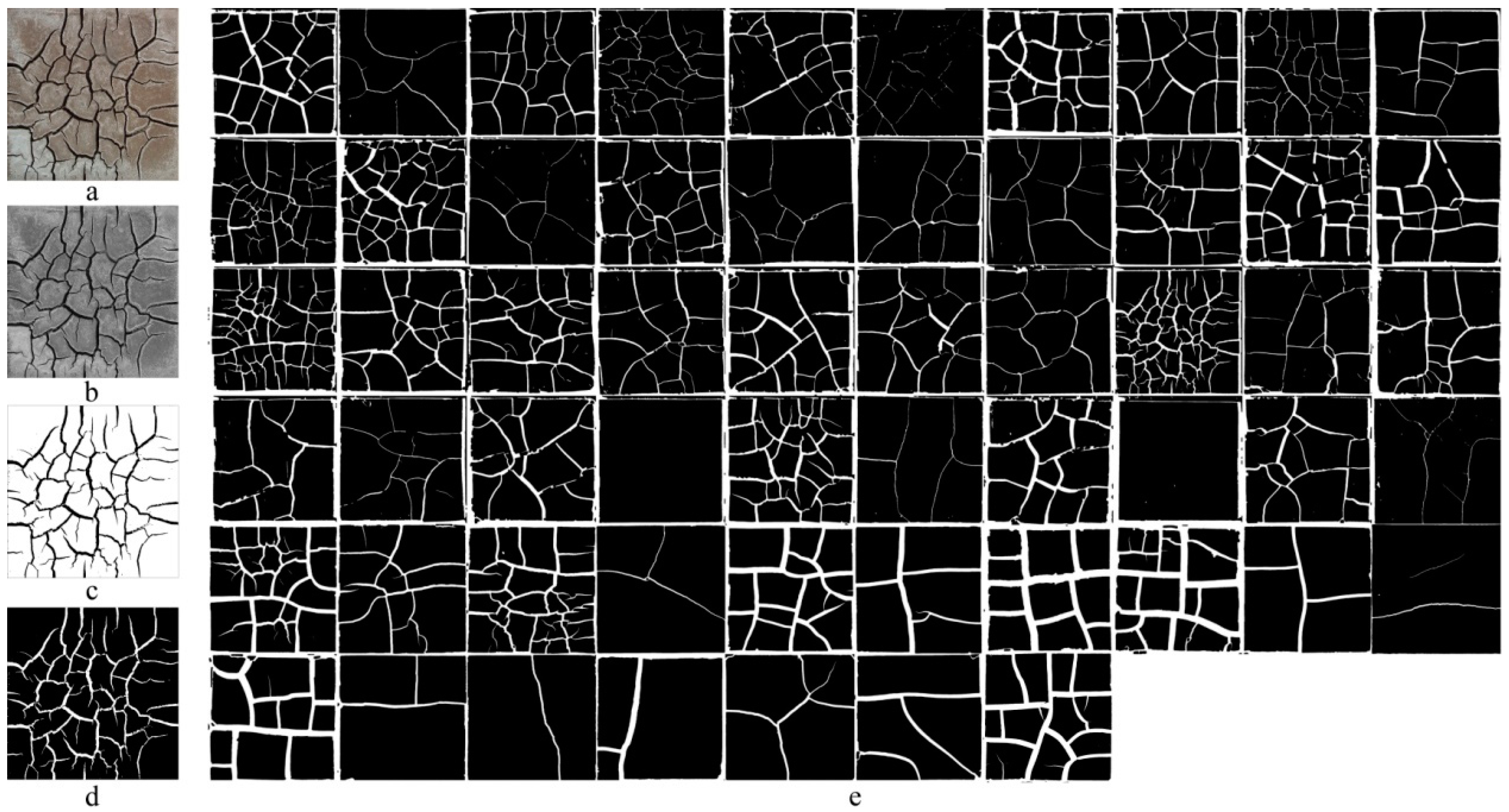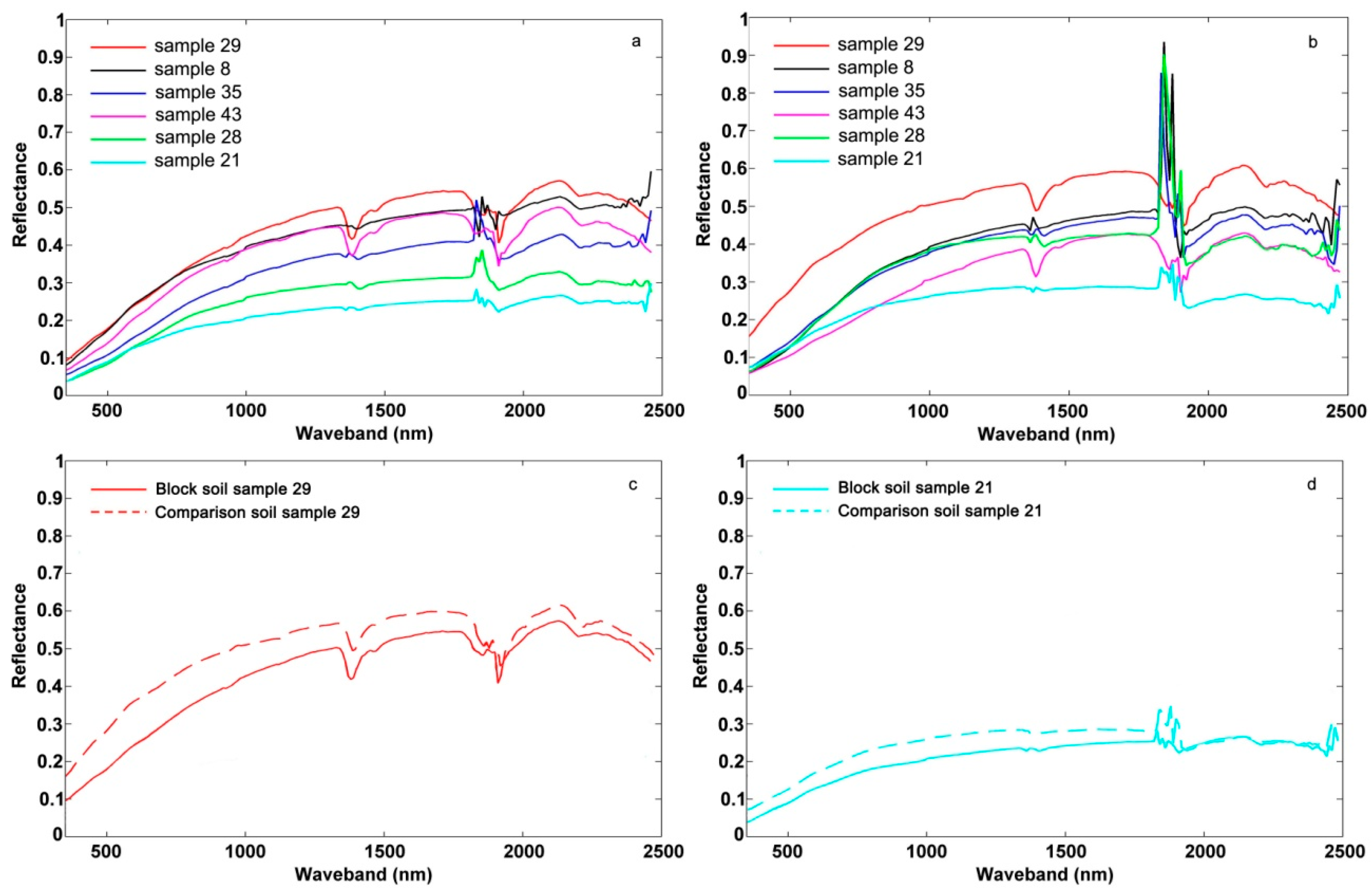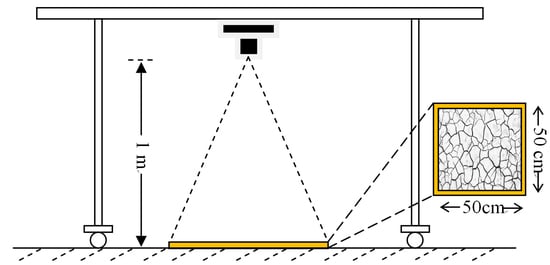Quantitative Analysis of Spectral Response to Soda Saline-AlkaliSoil after Cracking Process: A Laboratory Procedure to Improve Soil Property Estimation
Abstract
:1. Introduction
2. Materials and Methods
2.1. Study Area and Sampling
2.2. Soil Property Measurement
2.3. Desiccation Cracking Test
2.4. Texture Feature Extraction
2.5. Spectral Features Acquisition
3. Results
3.1. Soil Properties
3.2. CON Texture Features
3.3. Spectral Characteristics
3.4. Correlation Analysis
3.5. Regression Models
4. Discussion
5. Conclusions
- The soil salinity can dominate the cracking process of soda saline-alkali soil to a certain extent for the soil with similar clay content and clay mineral composition.
- The spectral characteristics of the block soil samples are more correlated with soil properties than the comparison soil samples, the mixed reflectance of soil samples considering the CON texture feature can largely improve the prediction accuracy of the main soil properties.
- Linear regression models based on mixed reflectance considering the CON texture feature of block soil samples show good potential for predicting the main soil properties. For univariate linear regression models, R2 are 0.85, 0.83, 0.87, RPD are 2.81, 4.76, 4.48, for multivariate linear regression models, R2 are 0.88, 0.85, 0.88, RPD are 2.9, 4.81, 4.63.
Author Contributions
Funding
Acknowledgments
Conflicts of Interest
References
- Liu, H.; Xu, J.; Wu, X. Present situation and tendency of saline-alkali soil in west Jilin Province. J. Geogr. Sci. 2001, 11, 321–328. [Google Scholar]
- Pankova, E.I. Salt-affected soils of Russia: Solved and unsolved problems. Eurasian Soil Sci. 2015, 48, 115–127. [Google Scholar] [CrossRef]
- Daliakopoulos, I.N.; Tsanis, I.K.; Koutroulis, A.; Kourgialas, N.N.; Varouchakis, A.E.; Karatzas, G.P.; Ritsema, C.J. The threat of soil salinity: A European scale review. Sci. Total Environ. 2016, 573, 727–739. [Google Scholar] [CrossRef] [PubMed]
- Metternicht, G.I. Soils: Salinization. In The International Encyclopedia of Geography: People, the Earth, Environment and Technology; Wiley-Blackwell: Hoboken, NJ, USA, 2017; pp. 1–10. [Google Scholar]
- FAO (Food and Agricultural Organization of the United Nations). Extent and Causes of Salt-Affected Soils in Participating Countries; FAO (Food and Agricultural Organization of the United Nations): Rome, Italy, 2000. [Google Scholar]
- Wang, H.; Fan, Y.; Tashpolat, T. The research of soil salinization human impact based on remote sensing classification in oasis irrigation area. Proc. Environ. Sci. 2011, 10, 2399–2405. [Google Scholar]
- Singh, Y.P.; Nayak, A.K.; Sharma, D.K.; Singh, G.; Mishra, V.K.; Singh, D. Evaluation of Jatropha curcas genotypes for rehabilitation of degraded sodic lands. Land Degrad. Dev. 2015, 26, 510–520. [Google Scholar] [CrossRef]
- Fan, X.; Pedroli, B.; Liu, G.; Liu, Q.; Liu, H.; Shu, L. Soil salinity development in the yellow river delta in relation to groundwater dynamics. Land Degrad. Dev. 2012, 23, 175–189. [Google Scholar] [CrossRef]
- Hu, W.; Shao, M.; Wan, L.; Si, B. Spatial variability of soil electrical conductivity in a small watershed on the loess Plateau of China. Geoderma 2014, 230, 212–220. [Google Scholar] [CrossRef]
- Allbed, A.; Kumar, L.; Yousef, Y.A. Assessing soil salinity using soil salinity and vegetation indices derived from IKONOS high-spatial resolution imageries: Applications in a data palm dominated region. Geoderma 2014, 230, 1–8. [Google Scholar] [CrossRef]
- Li, H.; Webster, R.; Shi, Z. Mapping soil salinity in the Yangtze delta: REML and universal kriging (E-BLUP) revisited. Geoderma 2015, 237, 71–77. [Google Scholar] [CrossRef]
- Periasamy, S.; Shanmugam, R.S. Multispectral and microwave remote sensing models to survey soil moisture and salinity. Land Degrad. Dev. 2017, 28, 1412–1425. [Google Scholar] [CrossRef]
- Fourati, H.T.; Bouaziz, M.; Benzina, M. Detection of terrain indices related to soil salinity and mapping salt-affected soils using remote sensing and geostatistical techniques. Environ. Monit. Assess. 2017, 189, 177. [Google Scholar] [CrossRef] [PubMed]
- Weng, Y.; Gong, P.; Zhu, Z. A spectra index for estimating soil salinity in the Yellow River Delta Region of China using EO-1 Hyperion data. Pedosphere 2010, 20, 378–388. [Google Scholar] [CrossRef]
- Bilgili, A.V.; Cullu, M.A.; Vanes, H.; Aydemir, A.; Aydemir, S. The use of hyperspectral visible and near infrared reflectance spectroscopy for the characterization of salt-affected soils in the Harran Plain, Turkey. Arid Soil Res. Rehabil. 2011, 25, 19–37. [Google Scholar] [CrossRef]
- Zhang, F.; Tiyip, T.; Ding, J.; Kung, H.; Johnson, V.C.; Sawut, M.; Tashpolat, N.; Gui, D. Studies on the reflectance spectral features of saline soil along the middle reaches of Tarim River: A case study in Xinjiang Autonomous Region, China. Environ. Earth Sci. 2013, 69, 2743–2761. [Google Scholar] [CrossRef]
- Sakhaii, P.; Bermel, W. Improving the sensitivity of conventional spin echo spectra by preservation of initial signal-to-noise ratio. J. Magn. Reson. 2014, 242, 220–223. [Google Scholar] [CrossRef] [PubMed]
- Taylor, G.R.; Hemphill, P.; Currie, D.; Broadfoot, T.; Dehaan, R.L. Mapping dryland salinity with hyperspectral imagery. In Proceedings of the International Geoscience and Remote Sensing Symposium (IGARSS 2001), Sydney, Australia, 9–13 July 2001; Volume 1, pp. 302–304. [Google Scholar]
- Farifteh, J.; van der Meer, F.; van der Meijde, M.; Atzberger, C. Spectral characteristics of salt-affected soils: A laboratory experiment. Geoderma 2008, 145, 196–206. [Google Scholar] [CrossRef]
- Wang, Q.; Li, P.; Chen, X. Modeling salinity effects on soil reflectance under various moisture conditions and its inverse application: A laboratory experiment. Geoderma 2012, 170, 103–111. [Google Scholar] [CrossRef]
- Moreira, L.C.J.; Teixeira, A.S.; Galvao, L.S. Laboratory salinization of Brazilian alluvial soils and the spectral effects of gypsum. Remote Sens. 2014, 6, 2647–2663. [Google Scholar] [CrossRef]
- Zovko, M.; Romic, D.; Colombo, C.; Iorio, E.D.; Romic, M.; Buttafuoco, G.; Castrignano, A. A geostatistical Vis-NIR spectroscopy index to assess the incipient soil salinization in the Neretva River valley, Croatia. Geoderma 2018, 332, 60–72. [Google Scholar] [CrossRef]
- Masoud, A.A. Predicting salt abundance in slightly saline soils form Landsat ETM+ imagery using spectral mixture analysis and soil spectrometry. Geoderma 2014, 217–218, 45–56. [Google Scholar] [CrossRef]
- Nawar, S.; Buddenbaum, H.; Hill, J. Estimation of soil salinity using three quantitative methods based on visible and near-infrared reflectance spectroscopy: A case study from Egypt. Arab. J. Geosci. 2015, 8, 5127–5140. [Google Scholar] [CrossRef]
- Weng, Y.; Gong, P.; Zhu, Z. Soil salt content estimation in the Yellow River Delta with satellite hyperspectral data. Can. J. Remote Sens. 2008, 34, 259–270. [Google Scholar]
- Fan, X.; Liu, Y.; Tao, J.; Weng, Y. Soil salinity retrieval from advanced multi-spectral sensor with partial least square regression. Remote Sens. 2015, 7, 488–511. [Google Scholar] [CrossRef]
- Zhang, Y.; Hu, P.; Gao, J. A reflectance spectra-based approach to mapping salt fields using PCA-fused Landsat TM data. Adv. Space Res. 2011, 47, 1490–1496. [Google Scholar] [CrossRef]
- Sidike, A.; Zhao, S.H.; Wen, Y.M. Estimating soil salinity in Pingluo County of China using QuickBird data and soil reflectance spectra. Int. J. Appl. Earth Obs. Geoinfor. 2014, 26, 156–175. [Google Scholar] [CrossRef]
- Nawar, S.; Buddenbaum, H.; Hill, J.; Kozak, J. Modeling and mapping of soil salinity with reflectance spectroscopy and Landsat data using two quantitative methods (PLSR and MARS). Remote Sens. 2014, 6, 10813–10834. [Google Scholar] [CrossRef]
- Ren, J.; Zhao, K.; Wu, X.; Zheng, X.; Li, X. Comparative analysis of the spectral response to soil salinity of saline-sodic soils under different surface conditions. Int. J. Environ. Res. Public Health 2018, 15, 2721. [Google Scholar] [CrossRef] [PubMed]
- Li, X.; Ren, J.; Zhao, K.; Liang, Z. Correlation between spectral characteristics and physicochemical parameters of soda-saline soils in different states. Remote Sens. 2019, 11, 388. [Google Scholar] [CrossRef]
- Lloyd, K.; Rosin, P.L.; Marshall, D.; Moore, S.C. Detecting violent and abnormal crowd activity using temporal analysis of grey co-occurrence matrix (GLCM)-based texture measures. Math. Vis. Appl. 2017, 28, 361–371. [Google Scholar] [CrossRef]
- Olaniyi, E.O.; Adekunle, A.A.; Odekuoye, T.; Khashman, A. Automatic system for grading banana using GLCM texture feature extraction and neural network arbitrations. J. Food Eng. 2017, 40, e12575. [Google Scholar] [CrossRef]
- Arabi, P.M.; Joshi, G.; Deepa, N.V. Performance evaluation of GLCM and pixel intensity matrix for skin texture analysis. Perspect. Sci. 2016, 8, 203–206. [Google Scholar] [CrossRef] [Green Version]
- Malegori, C.; Franzetti, L.; Guidetti, R.; Casiraghi, E.; Rossi, R. GLCM, an image analysis technique for early detection of biofilm. J. Food Eng. 2016, 185, 48–55. [Google Scholar] [CrossRef]
- Liang, L.; Li, L.; Liu, Q. Precipitation variability in Northeast China from 1961 to 2008. J. Hydrol. 2011, 404, 67–76. [Google Scholar] [CrossRef]
- Bao, S. Agricultural Chemistry Analysis of Soils; Chinese Agriculture Press: Beijing, China, 2000; pp. 152–200. [Google Scholar]
- Eshel, G.; Levy, G.J.; Mingelgrin, U. Critical evaluation of the use of laser diffraction for particle-size distribution analysis. Soil Sci. Soc. Am. J. 2004, 68, 736–743. [Google Scholar] [CrossRef]
- Rafi, M.; Mukhopadhyay, S. Texture description using multi-scale morphological GLCM. Multimed. Tools Appl. 2018, 77, 30505–30532. [Google Scholar] [CrossRef]
- Tan, T.C.Y.; Ritter, L.J.; Whitty, A.; Fernandez, R.C.; Moran, L.J.; Robertson, S.A.; Thompson, J.G.; Brown, H.M. Gray level co-occurrence matrices (GLCM) to assess microstructural and texture changes in pre-implantation embryos. Mol. Reprod. Dev. 2016, 83, 701–713. [Google Scholar] [CrossRef]
- Wang, J.; Ren, X. GLCM based extraction of flame image texture features and KPCA-GLVQ recognition method for rotary kiln combustion working conditions. Int. J. Autom. Comput. 2014, 11, 72–77. [Google Scholar] [CrossRef]
- Shahbahrami, A.; Pham, T.A.; Bertel, K. Parallel implementation of Gray Level Co-occurrence Matrices and Haralick texture features on cell architecture. J. Supercomput. 2012, 59, 1455–1477. [Google Scholar] [CrossRef]
- Ren, J.; Li, X.; Zhao, K.; Fu, B.; Jiang, T. Study of an on-line measurement method for the salt parameters of soda-saline soils based on the texture of features of cracks. Geoderma 2016, 263, 60–69. [Google Scholar] [CrossRef]
- Chhabra, R. Classification of salt-affected soils. Arid Land Res. Manag. 2005, 19, 61–79. [Google Scholar] [CrossRef]
- Amarasiri, A.L.; Kodikara, J.K.; Costa, S. Numerical modeling of desiccation cracking. Int. J. Numer. Anal. Methods Geomech. 2011, 35, 82–96. [Google Scholar] [CrossRef]
- Trabelsi, H.; Jamei, M.; Zenzri, H.; Olivella, S. Crack patterns in clayey soils: Experiments and modeling. Int. J. Numer. Anal. Methods Geomech. 2012, 36, 1410–1433. [Google Scholar] [CrossRef]
- Boivin, P.; Garnier, P.; Tessier, D. Relationship between clay content, clay type and shrinkage properties of soil samples. Soil Sci. Soc. Am. J. 2004, 68, 1145–1153. [Google Scholar] [CrossRef]
- Du, C.; Yang, Z.; Xiong, D.; Zhou, H. Facts and envisage of soil swelling-shrinkage. Res. Soil Water Conserv. 2006, 13, 269–273, (In Chinese with English abstract). [Google Scholar]
- Zhang, Z.; Peng, X. A review of researches on soil cracks and their impacts on preferential flow. Acta Pedol. Sin. 2015, 52, 477–488, (In Chinese with English abstract). [Google Scholar]
- Gray, C.W.; Allbrook, R. Relationships between shrinkage indices and soil properties in some New Zealand soils. Geoderma 2002, 108, 287–299. [Google Scholar] [CrossRef]
- Greene-Kelly, R. Shrinkage of clay soils: A statistical correlation with other soil properties. Geoderma 1974, 11, 243–257. [Google Scholar] [CrossRef]
- Chen, A.; Zhang, D.; Lei, B.; Yang, Y.; Liu, G. Effects of contraction and deformation of vertisol on its crack development and shear strength in Yuanmou Dry-Hot Valley. Chin. J. Soil Sci. 2015, 46, 341–347, (In Chinese with English abstract). [Google Scholar]
- Zhang, G.; Yu, Q.; Wei, G.; Chen, B.; Yang, L.; Hu, C.; Li, J.; Chen, H. Study on the basic properties of the Songnen Plain saline-alkali soil. Hydrogeol. Eng. Geol. 2007, 2, 37–40, (In Chinese with English abstract). [Google Scholar]
- Hallett, P.D.; Newson, T.A. Describing soil crack formation using elastic-plastic fracture mechanics. Eur. J. Soil Sci. 2005, 56, 31–38. [Google Scholar] [CrossRef]
- Zhang, G.; Li, J.; Yu, Q.; Zhang, B.; Yang, R.; Chen, H. Influence of salt content on shearing strength of the carbonate saline soil in Songnen Plain. Chin. J. Geol. Hazard Control 2008, 19, 128–131, (In Chinese with English abstract). [Google Scholar]
- Wang, W.; Wang, Q.; Zhang, J.; Chen, H. An experiment of the environmental property of the carbonate-saline soil in west of Jilin Province. J. B Univ. Technol. 2011, 37, 217–224, (In Chinese with English abstract). [Google Scholar]
- Yu, Q.; Sun, W.; Chen, B.; Yang, L.; Zhang, G. Research on strength of Songnen Plain soda-saline soil. Rock Soil Mech. 2008, 29, 1793–1796, 1801, (In Chinese with English abstract). [Google Scholar]
- Jeong, S.W.; Locat, J.; Leroueil, S. The effects of salinity and shear history on the rheological characteristics of illite-rich and Na-montmorillonite-rich clays. Clays Clay Miner. 2012, 60, 108–120. [Google Scholar] [CrossRef]
- DeCarlo, K.F.; Shokri, N. Salinity effects on cracking morphology and dynamics in 3-D desiccating clays. Water Resour. Res. 2014, 50, 3052–3072. [Google Scholar] [CrossRef]
- Shokri, N.; Zhou, P.; Keshmiri, A. Patterns of desiccation cracks in saline bentonite layers. Transp. Porous Media 2015, 110, 333–344. [Google Scholar] [CrossRef]
- Zhang, X.; Chen, Y.; Ye, W.; Cui, Y.; Deng, Y.; Chen, B. Effect of salt concentration on desicction cracking behaviour of GMZ bentonite. Environ. Earth Sci. 2017, 76, 531. [Google Scholar] [CrossRef]
- Howari, F.M.; Goodell, P.C.; Miyamoto, S. Spectral properties of salt crusts formed on saline soils. J. Environ Qual. 2002, 31, 1453–1461. [Google Scholar] [CrossRef]
- Farifteh, J.; Farshad, A.; George, R.J. Assessing salt-affected soils using remote sensing solute modeling, and geophysics. Geoderma 2006, 130, 191–206. [Google Scholar] [CrossRef]
- Farifteh, J.; Van der Meer, F.; Carranza, E.J.M. Similarity measures for spectral discrimination of salt-affected soils. Int. J. Remote Sens. 2007, 28, 5273–5293. [Google Scholar] [CrossRef]
- Wang, Q.; Li, P.; Maina, J.N.; Chen, X. Study of how salt types greatly shape soil reflectance spectra versus salt concentrations. Commun. Soil Sci. Plan. 2013, 44, 1503–1510. [Google Scholar] [CrossRef]
- Huang, C.H.; Xue, X.; Wang, T.; Mascellis, R.D.; Mele, G.; You, Q.G.; Peng, F.; Tedeschi, A. Effects of saline water irrigation on soil properties in northwest China. Environ. Earth Sci. 2011, 63, 701–708. [Google Scholar] [CrossRef]
- Tedeschi, A.; Dell’ Aquila, R. Effects of irrigation with saline waters, at different concentrations on soil physical and chemical characteristics. Agric. Water Manag. 2005, 77, 308–322. [Google Scholar] [CrossRef]
- Farifteh, J.; Van der Meer, F.; Atzberger, C.; Carranza, E.J.M. Quantitative analysis of salt-affected soil reflectance spectra: A comparison of two adaptive methods (PLSR and ANN). Remote Sens. Environ. 2007, 110, 59–78. [Google Scholar] [CrossRef]







| Min | Max | Mean | Std | CV (%) | Skewness | Kurtosis | |
|---|---|---|---|---|---|---|---|
| Na+ (mg/g) | 0.12 | 14.12 | 3.367 | 3.288 | 97.64 | 1.49 | 2.08 |
| K+ (mg/g) | 0.01 | 0.06 | 0.017 | 0.011 | 64.71 | 2.16 | 5.48 |
| Ca2+ and Mg2+ (mg/g) | 0.01 | 1.6 | 0.539 | 0.318 | 59.01 | 1.18 | 1.66 |
| Cl− (mg/g) | 0.08 | 5.25 | 1.343 | 1.465 | 109.08 | 1.31 | 0.81 |
| CO32− (mg/g) | 0 | 5.51 | 1.776 | 1.562 | 87.95 | 1.01 | 0.11 |
| HCO3− (mg/g) | 0.15 | 4.99 | 1.591 | 0.982 | 61.72 | 1.15 | 1.44 |
| EC (ds/m) | 0.06 | 3.39 | 0.991 | 0.841 | 84.86 | 1.01 | 0.54 |
| pH | 8.01 | 10.77 | 9.861 | 0.706 | 7.16 | −1.21 | 0.48 |
| Salinity (mg/g) | 1.06 | 29.73 | 8.63 | 6.441 | 74.63 | 1.22 | 1.43 |
| Clay (%) | 25.39 | 32.04 | 27.981 | 1.54 | 5.49 | 0.43 | −0.27 |
| Silt (%) | 28.72 | 40.4 | 35.191 | 3.18 | 9.03 | −0.12 | −0.82 |
| Sand (%) | 28.26 | 43.94 | 36.848 | 3.64 | 9.87 | −0.21 | −0.85 |
| Soil Property | Spectra Type | Univariate Linear Regression Models | R2 | P-Value |
|---|---|---|---|---|
| Na+ | C-Original | Y = −23.77 R1990 + 14.38 | 0.41 | 1.51 × 10−5 |
| B-Original | Y = −36.29R1990 + 19.15 | 0.74 | 4.33 × 10−12 | |
| C-Calculated | Y = −26.60 R1990 + 14.00 | 0.66 | 5.63 × 10−10 | |
| B-Calculated | Y = −32.75 R1990 + 16.03 | 0.81 | 4.01 × 10−16 | |
| EC | C-Original | Y = −5.80 R1990 + 3.67 | 0.39 | 3.31 × 10−5 |
| B-Original | Y = −9.23R1990 + 5.02 | 0.68 | 1.57 × 10−10 | |
| C-Calculated | Y = −6.72 R1990 + 3.69 | 0.60 | 1.12 × 10−8 | |
| B-Calculated | Y = −8.56 R1990 + 4.32 | 0.82 | 7.94 × 10−15 | |
| pH | C-Original | Y = −2.61R1990 + 10.99 | 0.10 | 0.057 |
| B-Original | Y = −4.80R1990 + 11.90 | 0.23 | 0.003 | |
| C-Calculated | Y = −3.36 R1990 + 11.16 | 0.18 | 0.007 | |
| B-Calculated | Y = −5.05 R1990 + 11.77 | 0.35 | 1.01 × 10−4 | |
| Salinity | C-Original | Y = −48.14R1990 + 30.71 | 0.45 | 4.01 × 10−6 |
| B-Original | Y = −73.55R1990 + 40.99 | 0.72 | 1.63 × 10−11 | |
| C-Calculated | Y = −55.01 R1990 + 31.00 | 0.67 | 3.52 × 10−10 | |
| B-Calculated | Y = −67.57 R1990 + 35.13 | 0.83 | 3.58 × 10−16 |
| Soil Property | Spectra Type | Multivariate Linear Regression Models | R2 | P-Value |
|---|---|---|---|---|
| Na+ | C-Original | Y = −4.28R990 + 57.49R1470 − 26.10R1990 −46.37R2170 + 14.22 | 0.44 | 0.001 |
| B-Original | Y = −6.17R990 + 27.42R1470 − 30.81R1990 − 25.00R2170 + 18.54 | 0.75 | 1.62 × 10−9 | |
| C-Calculated | Y = 25.35R990 − 24.98R1470 + 40.56R1990 − 62.65R2170 + 15.06 | 0.70 | 3.63 × 10−8 | |
| B-Calculated | Y = 2.97R990 − 7.39R1470 − 6.67R1990 − 20.97R2170 + 16.58 | 0.84 | 8.44 × 10−13 | |
| EC | C-Original | Y = −0.35R990 + 18.37R1470 − 13.21R1990 −9.02R2170 + 3.53 | 0.42 | 0.001 |
| B-Original | Y = −0.25R990 + 7.16R1470 − 17.75R1990 + 1.96R2170 + 4.71 | 0.70 | 3.27 × 10−8 | |
| C-Calculated | Y = 6.81R990 + 2.18R1470 + 7.31R1990 − 20.85R2170 + 3.89 | 0.65 | 3.18 × 10−7 | |
| B-Calculated | Y = 2.29R990 − 2.27R1470 − 11.27R1990 + 2.70R2170 + 4.38 | 0.83 | 6.83 × 10−12 | |
| pH | C-Original | Y = 3.61R990 + 13.56R1470 − 16.94R1990 −0.90R2170 + 10.79 | 0.17 | 0.17 |
| B-Original | Y = −3.79R990 + 7.37R1470 − 8.96R1990 + 0.80R2170 + 11.48 | 0.25 | 0.046 | |
| C-Calculated | Y = 6.88R990 + 15.05R1470 − 0.40R199 0−21.58R2170 + 11.17 | 0.29 | 0.019 | |
| B-Calculated | Y = −3.21R990 + 1.41R1470 − 1.49R1990 −1.91R2170 + 11.70 | 0.36 | 0.004 | |
| Salinity | C-Original | Y = −0.84R990 + 101.25R1470 − 18.09R1990 −120.41R2170 + 30.99 | 0.49 | 1.21 × 10−4 |
| B-Original | Y = −34.02R990 + 110.09R1470 − 66.25R1990 −77.35R2170 + 37.64 | 0.75 | 2.13 × 10−9 | |
| C-Calculated | Y = 24.20R990 + 12.51R1470 + 72.43R1990 −154.50R2170 + 32.65 | 0.71 | 1.86 × 10−8 | |
| B-Calculated | Y = −19.23R990 + 46.14R1470 − 8.90R1990 − 82.45R2170 + 34.83 | 0.85 | 3.80 × 10−13 |
| Na+ | EC | pH | Salinity | |
|---|---|---|---|---|
| CON | 0.93 | 0.94 | 0.68 | 0.95 |
| Maximum % | Minimum % | Mean % | Variance % |
|---|---|---|---|
| 2.34 | 0.18 | 1.97 | 0.03 |
| Soil Property | Regression Type | Spectra Type | RMSE | RMSE% | MAE | MAE% | RPD |
|---|---|---|---|---|---|---|---|
| Na+ | Univariate | C-Calculated | 2.53 | 66.55 | 1.94 | 50.99 | 1.53 |
| B-Calculated | 1.48 | 38.92 | 1.20 | 31.70 | 2.81 | ||
| Multivariate | C-Calculated | 2.51 | 66.13 | 1.84 | 48.59 | 1.56 | |
| B-Calculated | 1.42 | 37.50 | 1.16 | 30.62 | 2.90 | ||
| EC | Univariate | C-Calculated | 0.58 | 54.52 | 0.49 | 45.38 | 1.79 |
| B-Calculated | 0.33 | 31.26 | 0.28 | 26.26 | 4.76 | ||
| Multivariate | C-Calculated | 0.59 | 54.78 | 0.46 | 43.11 | 1.82 | |
| B-Calculated | 0.34 | 31.72 | 0.28 | 26.35 | 4.81 | ||
| pH | Univariate | C-Calculated | 0.52 | 5.27 | 0.44 | 4.43 | 20.15 |
| B-Calculated | 0.53 | 5.34 | 0.47 | 4.74 | 19.87 | ||
| Multivariate | C-Calculated | 0.67 | 6.75 | 0.55 | 5.48 | 14.98 | |
| B-Calculated | 0.51 | 5.13 | 0.43 | 4.33 | 20.85 | ||
| Salinity | Univariate | C-Calculated | 2.53 | 47.04 | 3.52 | 40.10 | 2.05 |
| B-Calculated | 1.48 | 24.56 | 1.76 | 20.09 | 4.48 | ||
| Multivariate | C-Calculated | 2.51 | 44.99 | 3.06 | 34.91 | 2.16 | |
| B-Calculated | 1.42 | 24.79 | 1.78 | 20.24 | 4.63 |
© 2019 by the authors. Licensee MDPI, Basel, Switzerland. This article is an open access article distributed under the terms and conditions of the Creative Commons Attribution (CC BY) license (http://creativecommons.org/licenses/by/4.0/).
Share and Cite
Ren, J.; Li, X.; Li, S.; Zhu, H.; Zhao, K. Quantitative Analysis of Spectral Response to Soda Saline-AlkaliSoil after Cracking Process: A Laboratory Procedure to Improve Soil Property Estimation. Remote Sens. 2019, 11, 1406. https://doi.org/10.3390/rs11121406
Ren J, Li X, Li S, Zhu H, Zhao K. Quantitative Analysis of Spectral Response to Soda Saline-AlkaliSoil after Cracking Process: A Laboratory Procedure to Improve Soil Property Estimation. Remote Sensing. 2019; 11(12):1406. https://doi.org/10.3390/rs11121406
Chicago/Turabian StyleRen, Jianhua, Xiaojie Li, Sijia Li, Honglei Zhu, and Kai Zhao. 2019. "Quantitative Analysis of Spectral Response to Soda Saline-AlkaliSoil after Cracking Process: A Laboratory Procedure to Improve Soil Property Estimation" Remote Sensing 11, no. 12: 1406. https://doi.org/10.3390/rs11121406
APA StyleRen, J., Li, X., Li, S., Zhu, H., & Zhao, K. (2019). Quantitative Analysis of Spectral Response to Soda Saline-AlkaliSoil after Cracking Process: A Laboratory Procedure to Improve Soil Property Estimation. Remote Sensing, 11(12), 1406. https://doi.org/10.3390/rs11121406






